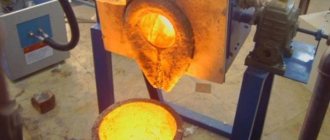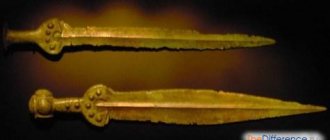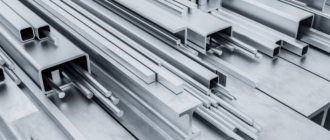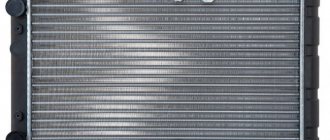Thermal conductivity and density of aluminum
The table shows the thermophysical properties of aluminum Al depending on temperature.
The properties of aluminum are given over a wide temperature range - from minus 223 to 1527 ° C (from 50 to 1800 K). As can be seen from the table, the thermal conductivity of aluminum at room temperature is about 236 W/(m deg) , which makes it possible to use this material for the manufacture of radiators and various heat sinks.
In addition to aluminum, copper also has high thermal conductivity. Which metal has the greater thermal conductivity? It is known that the thermal conductivity of aluminum at medium and high temperatures is still less than that of copper, however, when cooled to 50K, the thermal conductivity of aluminum increases significantly and reaches a value of 1350 W/(m deg). For copper, at such a low temperature, the thermal conductivity value becomes lower than for aluminum and amounts to 1250 W/(m deg).
Aluminum begins to melt at a temperature of 933.61 K (about 660 ° C), while some of its properties undergo significant changes. The values of properties such as thermal diffusivity, aluminum density and thermal conductivity are significantly reduced.
The density of aluminum is mainly determined by its temperature and depends on the state of aggregation of this metal. For example, at a temperature of 27°C, the density of aluminum is 2697 kg/m3 , and when this metal is heated to its melting point (660°C), its density becomes equal to 2368 kg/m3. The decrease in aluminum density with increasing temperature is due to its expansion when heated.
The table shows the following thermophysical properties of aluminum:
- aluminum density, g/cm 3 ;
- specific (mass) heat capacity, J/(kg deg);
- thermal diffusivity coefficient, m 2 /s;
- thermal conductivity of aluminum, W/(m deg);
- electrical resistivity, Ohm m;
- Lorentz function.
Properties of aluminum alloys with silicon, copper, magnesium and zinc
The table presents the composition and the following thermophysical properties of aluminum alloys:
- density of alloys, kg/m 3 ;
- thermal conductivity coefficient, W/(m °C);
- coefficient of linear thermal expansion, 1/deg;
- corrosion resistance in water and air;
- temperature of strength change.
The density, thermal conductivity and coefficient of linear thermal expansion of the alloys are presented as a function of temperature in the range from 500 to 660°C. The density of aluminum alloys with silicon and zinc is the highest. Light alloys include alloys containing magnesium.
Specific heat capacity of aluminum
The specific heat capacity of aluminum depends significantly on temperature and at room temperature is about 904 J/(kg deg) , which is significantly higher than the specific (mass) heat capacity of other common metals, such as copper and iron.
Below is a comparative table of the specific heat capacities of these metals. The heat capacity values in the table are in the temperature range from -223 to 927°C.
According to the table, it can be seen that the value of the specific heat capacity of aluminum is significantly higher than the value of this property for copper and iron , therefore this property of aluminum, such as the ability to accumulate heat well, is widely used in industry and heating engineering, making this metal irreplaceable.
Source
Physical properties of metal
Aluminum is a chemical element (atomic number 13). It belongs to the group of light metals and is a common element found in the earth's crust. Paramagnetic metal has a silvery-white color, it is very easy to machine, and it is convenient to cast products from it.
The metal has high thermal and electrical conductivity. It is resistant to air due to the ability to form metal oxide films that protect the surface from the influence of the external environment.
The film is destroyed under the influence of alkaline solutions. To prevent the metal from reacting with aggressive liquids, indium, tin or gallium are added to the alloy.
The specific heat of fusion is 390 kJ/kg, and the specific heat of evaporation is 10.53 MJ/kg. The metal boils at a temperature of 2500°C. The melting gradient depends on the degree of purification of the material and is accordingly:
Aluminum easily forms alloys, among which everyone knows compounds with copper, magnesium, and silicon. In the jewelry industry, this metal is combined with gold, which gives the composition new physical properties.
Aluminum easily forms alloys.
In nature, a chemical element forms natural compounds. It is found in minerals such as:
In some places (volcano vents) native metal can be found in small quantities.
Tables of specific heat capacity of substances (gases, liquids, etc.)
Tables of specific heat capacity of substances are presented: gases, metals, liquids, construction and thermal insulation materials, as well as food products - more than 400 substances and materials.
The specific heat capacity of a substance is the ratio of the amount of heat imparted to a unit mass of this substance in any process to the corresponding change in its temperature.
The specific heat capacity of substances depends on their chemical composition, thermodynamic state and the method of imparting heat to them. In the International System of Units, this value is measured in J/(kg K).
It should be noted that the experimental determination of the specific heat capacity of liquids and gases is carried out at constant pressure or at constant volume. In the first case, the specific heat capacity is denoted Cp , in the second - Cv . For liquids and gases, the most commonly used specific heat capacity at constant pressure is Cp.
For solids, the heat capacities Cp and Cv do not differ. In addition, in relation to solids, in addition to the specific mass heat capacity, specific atomic and molar heat capacities are also used.
Thermal conductivity, heat capacity and resistivity of alloy 1151T
The table shows the values of the thermal conductivity coefficient, W/(m deg), specific (mass) heat capacity, kJ/(g deg) and resistivity of aluminum alloy 1151T.
The properties of aluminum alloy 1151T are given depending on temperature (in the range from 0 to 400 ° C). According to the table, it can be seen that the thermal conductivity of this alloy increases when heated, but around a temperature of 200°C there is a slight decrease followed by an increase. The same nature of change is characteristic of the specific heat capacity of the 1151T alloy. The electrical resistivity of the alloy in question increases as its temperature increases.
Table of specific heat capacity of gases
The table shows the specific heat capacity of Cp gases at a temperature of 20°C and normal atmospheric pressure (101325 Pa).
Table of specific heat capacity of gases
| Gases | Cp, J/(kg K) |
| Nitrogen N2 | 1051 |
| Ammonia NH3 | 2244 |
| Argon Ar | 523 |
| Acetylene C2H2 | 1683 |
| Hydrogen H2 | 14270 |
| Air | 1005 |
| Helium He | 5296 |
| Oxygen O2 | 913 |
| Krypton Kr | 251 |
| Xenon Xe | 159 |
| Methane CH4 | 2483 |
| Neon Ne | 1038 |
| Nitric oxide N2O | 913 |
| Nitric oxide NO | 976 |
| Sulfur oxide SO2 | 625 |
| Carbon monoxide CO | 1043 |
| Propane C3H8 | 1863 |
| Hydrogen sulfide H2S | 1026 |
| Carbon dioxide CO2 | 837 |
| Chlorine Cl | 520 |
| Ethane C2H6 | 1729 |
| Ethylene C2H4 | 1528 |
Change in internal energy and temperature during melting
So where does the energy that we impart to the body go during melting?
You know that in crystalline solids, atoms (or molecules) are arranged in a strict order (Figure 1). They do not move as actively as in gases or liquids. However, they are also in thermal motion - oscillating.
Figure 1. Structure of crystalline quartz
Take another look at the ice melting and solidifying graph (Figure 2).
Figure 2. Graph of ice melting and solidification
The ice is heated in section AB. At this time, the average speed of movement of its molecules increases. This means that their average kinetic energy and temperature also increase. The range of vibrations of atoms (or molecules) increases.
This happens until the heated body reaches its melting point.
At the melting temperature, the order in the arrangement of particles in crystals is disrupted.
This is how the substance begins the transition from solid to liquid.
This means that the energy that the body receives after reaching the melting temperature is spent on the destruction of the crystal lattice. Therefore, body temperature does not increase - part of the BC graph.
Table of specific heat capacity of some metals and alloys
The table shows the specific heat capacity of some common metals and alloys at a temperature of 20°C. You can find the heat capacity values of most metals at other temperatures in this table.
Table of specific heat capacity of metals and alloys
| Metals and alloys | C, J/(kg K) |
| Aluminum Al | 897 |
| Aluminum bronze | 420 |
| Tin bronze | 380 |
| Tungsten W | 134 |
| Duralumin | 880 |
| Iron Fe | 452 |
| Au Gold | 129 |
| Constantan | 410 |
| Brass | 378 |
| Manganin | 420 |
| Copper Cu | 383 |
| Nickel Ni | 443 |
| Nichrome | 460 |
| Tin Sn | 228 |
| Platinum Pt | 133 |
| Mercury Hg | 139 |
| Lead Pb | 128 |
| Silver Ag | 235 |
| Reinforcing rod steel | 482 |
| Carbon steel | 468 |
| Chrome steel | 460 |
| Titan Ti | 520 |
| Uranium U | 116 |
| Zinc Zn | 385 |
| White cast iron | 540 |
| Gray cast iron | 470 |
Change in internal energy and temperature during solidification
During hardening, the opposite happens.
The average speed of movement of molecules and their average kinetic energy in a liquid (molten substance) decreases upon cooling . This corresponds to the section of the DE graph in Figure 2.
Now the attractive forces between the molecules can hold them close to each other. The arrangement of particles becomes ordered - a crystal is formed (section of the EF graph).
Where is the energy released during crystallization spent? The body temperature remains constant during this process. This means that energy is spent maintaining this temperature until the body completely hardens.
Now we can say that
At the melting point, the internal energy of a substance in the liquid state is greater than the internal energy of the same mass of substance in the solid state.
This excess energy is released during crystallization and maintains the body temperature at the same level throughout the solidification process.
Table of specific heat capacity of liquids
The table shows the specific heat capacity Cp of common liquids at temperatures of 10...25°C and normal atmospheric pressure.
Table of specific heat capacity of liquids
| Liquids | Cp, J/(kg K) |
| Nitric acid (100%) NH3 | 1720 |
| Aniline C6H5NH2 | 2641 |
| Antifreeze (antifreeze) | 2990 |
| Acetone C3H6O | 2160 |
| Petrol | 2090 |
| Aviation gasoline B-70 | 2050 |
| Benzene C6H6 | 1050 |
| Water H2O | 4182 |
| Sea water | 3936 |
| Water is heavy D2O | 4208 |
| Vodka (40% vol.) | 3965 |
| Aqueous sodium chloride solution (25%) | 3300 |
| Gas oil | 1900 |
| Ammonium hydroxide | 4610 |
| Glycerol C3H5(OH)3 | 2430 |
| Dauterm | 1590 |
| Carborane C2H12B10 | 1720 |
| Kerosene | 2085…2220 |
| Kefir | 3770 |
| Fuel oil | 2180 |
| AMG-10 oil | 1840 |
| Oil VM-4 | 1480 |
| Castor oil | 2219 |
| Corn oil | 1733 |
| MS-20 oil | 2030 |
| Refined sunflower oil | 1775 |
| Oil TM-1 | 1640 |
| Transformer oil | 1680 |
| Refined cottonseed oil | 1737 |
| Oil HF-22 | 1640 |
| Condensed milk with sugar | 3936 |
| Whole milk | 3906 |
| Oil | 2100 |
| Liquid paraffin (at 50C) | 3000 |
| Beer | 3940 |
| Sulfuric acid (100%) H2SO4 | 1380 |
| Carbon disulfide CS2 | 1000 |
| Silicone | 2060 |
| Turpentine | 1800 |
| Cream (35% fat) | 3517 |
| Grape juice | 2800…3690 |
| Methyl alcohol (methanol) CH3OH | 2470 |
| Ethyl alcohol (ethanol) C2H5OH | 2470 |
| Whey | 4082 |
| Toluene C7H8 | 1130 |
| Diesel fuel (diesel fuel) | 2010 |
| Jet fuel | 2005 |
| Hexamine C6H12N4 | 1470 |
| Freon-12 CCl2F2 | 840 |
| Ethyl ether C4H10O | 2340 |
Areas of application
The property of chemical element No. 13 to perfectly accumulate heat allows it to be widely used in industrial production and heating engineering.
Aluminum radiator.
Aluminum is used as a raw material to create building structures. It is lightweight, durable, stable and is an attractive raw material for the production of window structures.
The chemical element forms non-toxic oxides, which allows its use in the production of foil for the needs of the food industry. Aluminum is a raw material for creating space rockets and aircraft. Its high reflectivity determines its use in the manufacture of mirrors.
The specific heat capacity of a substance means the amount of heat required to heat a unit of substance by one degree. Most often, a mass of 1 kg is taken as a unit of substance. Less commonly used are units of volume, such as cubic meters or liters. In chemistry, thermochemical reactions use molar heat capacity, when a mole is taken as a unit of a substance. Specific heat capacity changes noticeably with changes in temperature and, to a greater extent, with changes in the state of aggregation of a substance; for example, the values of the heat capacity of water will be different in liquid, solid and gaseous states. The table below also indicates the temperature and state of aggregation of the substance. Specific heat capacity of materials
| Name of material | Temperature 0C | Specific heat | |
| kJ/(kg K) | cal/(g 0С) | ||
| Specific heat capacity of gases and vapors | |||
| Nitrogen | 0 — 200 | 1,0 | 0,25 |
| Hydrogen | 0 — 200 | 14,2 | 3,41 |
| water vapor | 100 — 500 | 2,0 | 0,48 |
| Air | 0 — 400 | 1,0 | 0,24 |
| Helium | 0 — 600 | 5,2 | 1,24 |
| Oxygen | 20 — 440 | 0,92 | 0,22 |
| Carbon monoxide | 26 — 200 | 1,0 | 0,24 |
| Alcohol vapor | 40 — 100 | 1,2 | 0,29 |
| Chlorine | 13 — 200 | 0,5 | 0,12 |
| Specific heat capacity of liquids at normal atmospheric pressure | |||
| Gasoline (B-70) | 20 | 2,05 | 0,49 |
| Water | 1 — 100 | 4,19 | 1,00 |
| Glycerol | 0 — 100 | 2,43 | 0,58 |
| Kerosene | 0 — 100 | 2,09 | 0,50 |
| Machine oil | 0 — 100 | 1,67 | 0,40 |
| Sunflower oil | 20 | 2,43 | 0,58 |
| Milk | 20 | 3,94 | 0,94 |
| Oil | 0 — 100 | 1,67 — 2,09 | 0,40 — 0,50 |
| Mercury | 0 — 300 | 0,138 | 0,033 |
| Alcohol | 20 | 2,47 | 0,59 |
| Ether | 18 | 3,34 | 0,80 |
| Specific heat capacity of molten metals and liquefied gases | |||
| Nitrogen | -200,4 | 2,01 | 0,48 |
| Aluminum | 660 — 1000 | 1,09 | 0,36 |
| Hydrogen | -257,4 | 7,41 | 1,77 |
| Air | -193,0 | 1,97 | 0,47 |
| Helium | -269,0 | 4,19 | 1,00 |
| Gold | 1055 — 1300 | 0,14 | 0,034 |
| Oxygen | -200,3 | 1,63 | 0,39 |
| Sodium | 100 | 1,34 | 0,33 |
| Tin | 250 | 0,25 | 0,060 |
| Lead | 327 | 0,16 | 0,039 |
| Silver | 960 — 1300 | 0,29 | 0,069 |
| Specific heat capacity of solids | |||
| Nitrogen solid | -250 | 0,46 | 0,11 |
| Concrete | 20 | 0,88 | 0,21 |
| Paper | 20 | 1,50 | 0,36 |
| The air is solid | -193 | 2,00 | 0,47 |
| Graphite | 0 — 100 | 0,75 | 0,18 |
| Tree: | |||
| oak | 0 — 100 | 2,40 | 0,57 |
| fur tree, pine tree | 0 — 100 | 2,70 | 0,65 |
| Rock salt | 0 — 100 | 0,92 | 0,22 |
| Stone | 0 — 100 | 0,84 | 0,20 |
| Brick | 0,88 | 0,21 | |
| Oxygen solid | -200,3 | 1,60 | 0,39 |
| Ice | -40 — 0 | 2,10 | 0,50 |
| Naphthalene | 20 | 1,30 | 0,31 |
| Paraffin | 20 | 2,89 | 0,69 |
| Cork | 0 — 100 | 2,00 | 0,48 |
| Glass: | |||
| ordinary | 0 — 100 | 0,67 | 0,16 |
| mirror | 0 — 100 | 0,79 | 0,19 |
| laboratory | 0 — 100 | 0,84 | 0,20 |
| Porcelain | 0 — 100 | 1,10 | 0,26 |
| Slate | 20 | 0,75 | 0,18 |
| Specific heat capacity of metals and alloys | |||
| Aluminum | 0 — 200 | 0,92 | 0,22 |
| Tungsten | 0 — 1000 | 0,15 | 0,035 |
| Iron | 0 — 500 | 0,54 | 0,13 |
| Gold | 0 — 500 | 0,13 | 0,032 |
| Iridium | 0 — 1000 | 0,15 | 0,037 |
| Magnesium | 0 — 500 | 1,10 | 0,27 |
| Copper | 0 — 500 | 0,40 | 0,097 |
| Nickel | 0 — 300 | 0,50 | 0,12 |
| Tin | 0 — 200 | 0,23 | 0,056 |
| Platinum | 0 — 500 | 0,14 | 0,033 |
| Lead | 0 — 300 | 0,14 | 0,033 |
| Silver | 0 — 500 | 0,25 | 0,059 |
| Steel | 50 — 300 | 0,50 | 0,12 |
| Zinc | 0 — 300 | 0,40 | 0,097 |
| Cast iron | 0 — 200 | 0,54 | 0,13 |
Relationship between units of specific heat capacity
| Units of specific heat capacity | J/(kg K) | kJ/ (kg K) | cal/(g · 0С) or kcal/(kg · 0С) |
| 1 J/(kg K) | 1 | 0,001 | 2,39 · 10-4 |
| 1 kJ/ (kg K) | 1000 | 1 | 0,239 |
| 1 cal/(g 0С) = 1 kcal/(kg 0С) | 4,19 · 103 | 4,19 | 1 |
| Note: 1 cal /(g 0С) = 1 kcal/(kg 0С) = 4186.8 J /(kg K) = 4.1868 kJ /(kg K). Degrees Celsius and Kelvin are equal in magnitude. | |||
Specific Heat Capacity Table for Solids
The table shows the specific heat capacity of solid substances: building materials (sand, asphalt, etc.), thermal insulation of various types and other common materials in the temperature range from 0 to 50 ° C at normal atmospheric pressure.
Specific Heat Capacity Table for Solids
| Construction, thermal insulation and other materials | C, J/(kg K) |
| ABS plastic | 1300…2300 |
| Aggloporite concrete and concrete based on fuel (boiler) slags | 840 |
| Diamond | 502 |
| Argillite | 700…1000 |
| Fibrous asbestos | 1050 |
| Asbestos cement | 1500 |
| Asbotekstolite | 1670 |
| Asboshifer | 837 |
| Asphalt | 920…2100 |
| Asphalt concrete | 1680 |
| Airgel (Aspen aerogels) | 700 |
| Basalt | 850…920 |
| Barite | 461 |
| Birch | 1250 |
| Concrete | 710…1130 |
| Bitumen perlite | 1130 |
| Petroleum bitumens for construction and roofing | 1680 |
| Paper | 1090…1500 |
| Mineral wool | 920 |
| Glass wool | 800 |
| Cotton wool | 1675 |
| Slag wool | 750 |
| Vermiculite | 840 |
| Vermiculite concrete | 840 |
| Viniplast | 1000 |
| Woolen felt | 1700 |
| Wax | 2930 |
| Gas and foam concrete, gas and foam silicate, gas and foam ash concrete | 840 |
| Getinax | 1400 |
| Dry molded gypsum | 1050 |
| Drywall | 950 |
| Clay | 750 |
| Fireproof clay | 800 |
| Alumina | 700…840 |
| Gneiss (facing) | 880 |
| Gravel (filler) | 850 |
| Expanded clay gravel | 840 |
| Shungizite gravel | 840 |
| Granite (cladding) | 880…920 |
| Graphite | 708 |
| Wet ground (soil) | 2010 |
| Lunar soil | 740 |
| Sandy soil | 900 |
| The soil is dry | 850 |
| Tar | 1675 |
| Diabase | 800…900 |
| Dinas | 737 |
| Dolomite | 600…1500 |
| Oak | 2300 |
| Reinforced concrete | 840 |
| Reinforced concrete | 840 |
| Wood ash | 750 |
| Limestone (cladding) | 850…920 |
| Products made from expanded perlite with a bitumen binder | 1680 |
| Sandy silt | 1000…2100 |
| Building stone | 920 |
| Capron | 2300 |
| Carbolite black | 1900 |
| Corrugated cardboard | 1150 |
| Cardboard facing | 2300 |
| Thick cardboard | 1200 |
| Multilayer construction cardboard | 2390 |
| Natural rubber | 1400 |
| Crystalline quartz | 836 |
| Quartzite | 700…1300 |
| Expanded clay | 750 |
| Expanded clay concrete and expanded clay foam concrete | 840 |
| Dinas brick | 905 |
| Carborundum brick | 700 |
| Red dense brick | 840…880 |
| Magnesite brick | 1055 |
| Facing brick | 880 |
| Fireproof semi-acid brick | 885 |
| Silicate brick | 750…840 |
| Construction brick | 800 |
| Treble brick | 710 |
| Fireclay brick | 930 |
| Masonry "Poroton" | 900 |
| Rubble masonry made of medium-density stones | 880 |
| Gas silicate masonry | 880 |
| Masonry made of ordinary clay bricks | 880 |
| Ceramic hollow brick masonry | 880 |
| Sand-lime brick masonry | 880 |
| Treble brick masonry | 880 |
| Slag brick masonry | 880 |
| Powdered coke | 1210 |
| Corundum | 711 |
| Oil paint (enamel) | 650…2000 |
| Silicon | 714 |
| Volcanic lava | 840 |
| Brass | 400 |
| Ice from heavy water | 2220 |
| Ice at 0°C | 2150 |
| Ice at -100°C | 1170 |
| Ice at -20°C | 1950 |
| Ice at -60°C | 1700 |
| Linoleum | 1470 |
| Asbestos-cement flat sheets | 840 |
| Gypsum cladding sheets (dry plaster) | 840 |
| Sunflower husk | 1500 |
| Magnetite | 586 |
| Malachite | 740 |
| Stitched fiberglass mats and strips | 840 |
| Mineral wool mats, stitched and with a synthetic binder | 840 |
| Chalk | 800…880 |
| Mikanite | 250 |
| Mipora | 1420 |
| Marble (cladding) | 880 |
| Deck flooring | 1100 |
| Naphthalene | 1300 |
| Nylon | 1600 |
| Neoprene | 1700 |
| Tow | 2300 |
| Paraffin | 2890 |
| Oak parquet | 1100 |
| Piece parquet | 880 |
| Panel parquet | 880 |
| Pumice concrete | 840 |
| Foam concrete | 840 |
| Foam plastic PVC-1 and PV-1 | 1260 |
| Expanded polystyrene | 1340 |
| Expanded polystyrene "Penoplex" | 1600 |
| Polyurethane foam | 1470 |
| Foam glass or gas glass | 840 |
| Glassine | 1680 |
| Reinforced ceramic ceiling with concrete filling without plaster | 850 |
| Flooring made of reinforced concrete elements with plaster | 860 |
| Monolithic flat reinforced concrete floor | 840 |
| Perlite concrete | 840 |
| Perlitoplast-concrete | 1050 |
| Perlite phosphogel products | 1050 |
| Sand for construction work | 840 |
| Fine river sand | 700…840 |
| Fine river sand (wet) | 2090 |
| Sand sugar | 1260 |
| Sand dry | 800 |
| Fir | 2700 |
| Polyester plastic | 1000…2300 |
| Cork plate | 1850 |
| Alabaster slabs | 750 |
| Wood-fiber and particle boards (chipboard, fiberboard) | 2300 |
| Gypsum slabs | 840 |
| Resol-formaldehyde foam boards | 1680 |
| Glass staple fiber boards with synthetic binder | 840 |
| Reed slabs | 2300 |
| Flax insulating slabs | 2300 |
| High-hardness mineral wool slabs | 840 |
| Semi-rigid mineral wool slabs with starch binder | 840 |
| Peat thermal insulation slabs | 2300 |
| Fiberboard and wood concrete slabs based on Portland cement | 2300 |
| Carpet covering | 1100 |
| Seamless gypsum floor | 800 |
| Polyvinyl chloride (PVC) | 920…1200 |
| Polycarbonate (Diflon) | 1100…1120 |
| Polymethyl methacrylate | 1200…1650 |
| Polypropylene | 1930 |
| Polystyrene UPP1, PPS | 900 |
| Polystyrene concrete | 1060 |
| Polyvinyl chloride | 1130…1200 |
| Polychlorotrifluoroethylene | 920 |
| High Density Polyethylene | 1900…2300 |
| Low density polyethylene | 1700 |
| Portland cement | 1130 |
| Cork | 2050 |
| Cork granulated | 1800 |
| Gypsum grout mortar | 900 |
| Gypsum perlite solution | 840 |
| Porous gypsum perlite solution | 840 |
| Lime-sand mortar | 840 |
| Lime mortar | 920 |
| Complex mortar (sand, lime, cement) | 840 |
| Cement-perlite mortar | 840 |
| Cement-sand mortar | 840 |
| Cement-slag mortar | 840 |
| Soft rubber | 1380 |
| Porous rubber | 2050 |
| Ordinary hard rubber | 1350…1400 |
| Ruberoid | 1500…1680 |
| Sulfur | 715 |
| Slate | 700…1600 |
| Mica | 880 |
| Epoxy resin | 800…1100 |
| Stale snow at 0°C | 2100 |
| Freshly fallen snow | 2090 |
| Pine and spruce | 2300 |
| Resinous pine 15% humidity | 2700 |
| Mirror glass (mirror) | 780 |
| Quartz glass | 890 |
| Laboratory glass | 840 |
| Ordinary glass, window | 670 |
| Flint glass | 490 |
| Glass wool | 800 |
| Fiberglass | 840 |
| Fiberglass | 800 |
| Pressed wood shavings | 1080 |
| Textolite | 1470…1510 |
| Tol | 1680 |
| Peat | 1880 |
| Peat slabs | 2100 |
| Tuff (facing) | 750…880 |
| Tufobeton | 840 |
| Charcoal | 960 |
| Coal | 1310 |
| Plywood | 2300…2500 |
| Porcelain | 750…1090 |
| Fibrolite (gray) | 1670 |
| Zircon | 670 |
| Chamotte | 825 |
| Slate | 750 |
| Granulated slag | 750 |
| Boiler slag | 700…750 |
| Cinder concrete | 800 |
| Slag pumice concrete (thermosite concrete) | 840 |
| Slag pumice foam and slag pumice gas concrete | 840 |
| Gypsum plaster | 840 |
| Polystyrene mortar plaster | 1200 |
| Lime plaster | 950 |
| Lime plaster with stone dust | 920 |
| Perlite plaster | 1130 |
| Facade plaster with polymer additives | 880 |
| Shungizite concrete | 840 |
| Crushed stone and sand from expanded perlite | 840 |
| Crushed stone from blast furnace slag, slag pumice and agloporite | 840 |
| Ebonite | 1430 |
| Ecowool | 2300 |
| Etrol | 1500…1800 |











